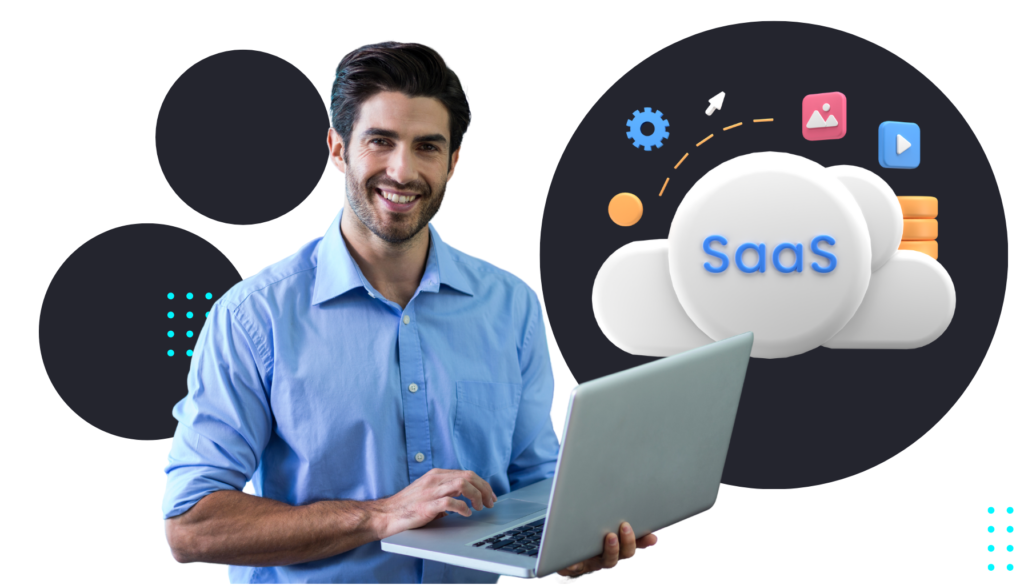
Software as a Service companies are constantly searching for innovative ways to stand out, attract, and retain customers. The heart of this challenge lies in effectively navigating the SaaS marketing funnel—a structured process that guides potential customers from initial awareness to loyal advocacy.
AI technologies are revolutionizing the way SaaS companies approach marketing, providing solutions that enhance targeting and personalization, enable predictive analytics, optimize content, prove marketing value, and streamline data management. From leveraging AI for more effective lead generation to enhancing lead nurturing practices, optimizing conversion rates, and beyond, AI is at the forefront of redefining SaaS marketing strategies.
Let’s discover how you can enhance your SaaS results with AI too.
Table of Contents
Understanding the SaaS Marketing Funnel
Understanding and optimizing your marketing funnel is crucial for both acquiring and retaining customers. The SaaS marketing funnel comprises several stages—awareness, consideration, conversion, retention, and advocacy—that guide a potential customer from first hearing about your product to becoming a loyal advocate. Each stage is vital, yet SaaS businesses often encounter challenges that hinder their growth and customer engagement. However, Artificial Intelligence presents innovative solutions to these challenges, revolutionizing how SaaS companies approach their marketing funnels.
The Stages of the SaaS Marketing Funnel
The SaaS marketing funnel often differs from other industries due to the unique nature of selling software products. Here’s how it typically differs:
Awareness Stage:
- In SaaS, the awareness stage often involves educating potential customers about the problem your software solves and the benefits it offers. This may include content marketing, social media engagement, and targeted advertising to reach relevant audiences.
- Compared to other industries, SaaS companies often rely heavily on digital marketing channels and content creation to generate awareness.
Consideration Stage:
- During this stage, SaaS companies focus on demonstrating the value of their software through free trials, demos, case studies, and customer testimonials.
- The consideration stage in SaaS marketing often involves a hands-on experience with the product, as users want to understand how it works and how it can benefit their specific needs.
- Unlike some other industries where the consideration stage might involve physical product demonstrations or in-person consultations, SaaS companies typically offer online resources and interactive experiences.
Decision Stage:
- In SaaS, the decision-making process often involves evaluating pricing plans, contract terms, and additional features or integrations.
- SaaS companies may offer incentives such as discounts for annual subscriptions, limited-time offers, or personalized onboarding assistance to help potential customers make their own decisions.
- The decision stage in SaaS marketing may also involve comparing the software to competitors and conducting thorough research before committing.
Retention and Advocacy:
- Retaining customers is crucial in the SaaS industry, as recurring subscriptions drive revenue. SaaS companies focus on providing ongoing value, excellent customer support, and regular updates to keep customers satisfied.
- Additionally, SaaS companies often leverage customer advocacy programs, referral incentives, and user communities to encourage satisfied customers to spread the word and refer new businesses.
Challenges Faced by SaaS Marketers
Navigating the SaaS marketing funnel is fraught with challenges that can significantly hinder a company’s growth and customer acquisition efforts. These challenges range from the initial stages of attracting leads to ultimately converting them into paying customers and proving the ROI of marketing efforts. Let’s delve deeper into each of these hurdles:
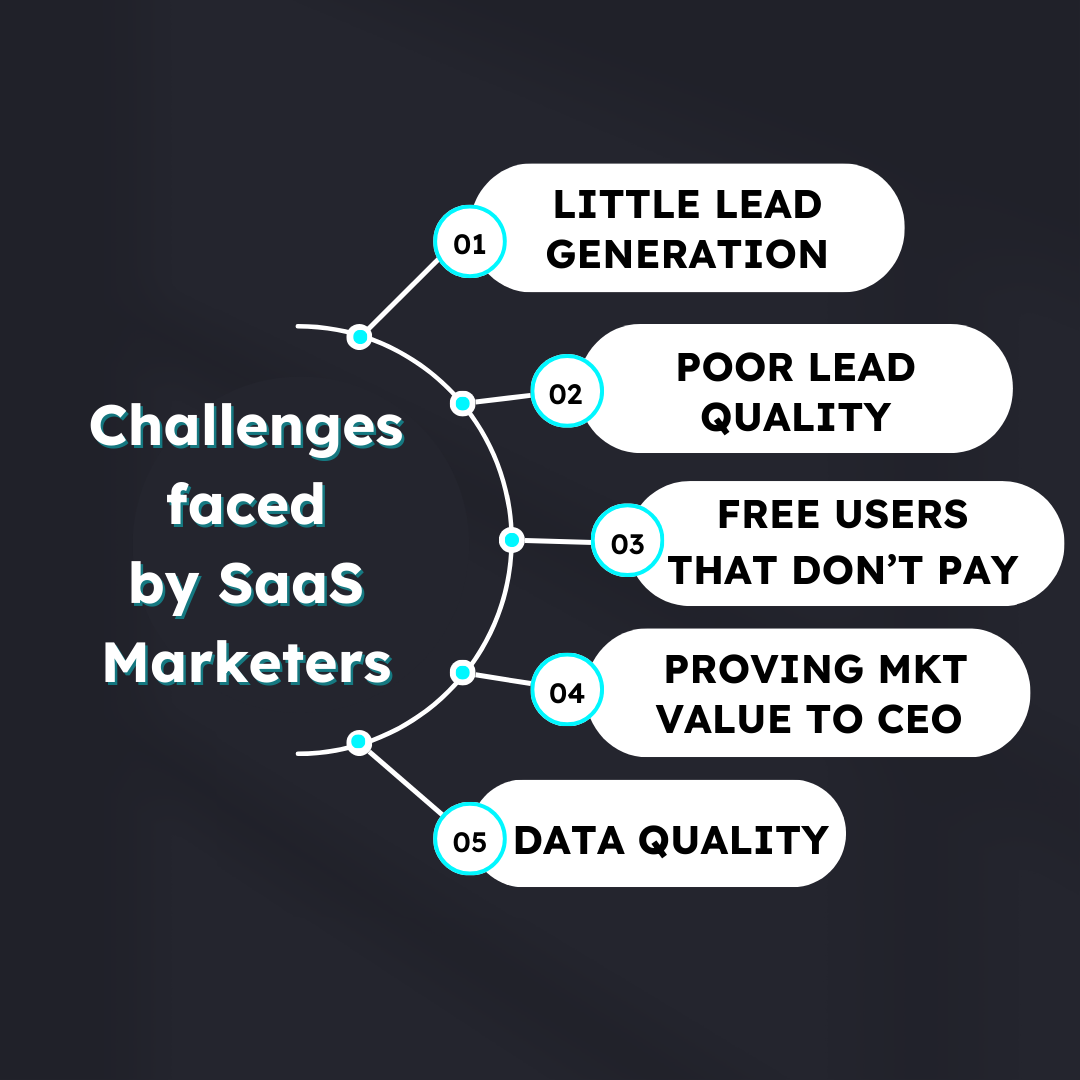
- Little Lead Generation
At the top of the funnel, many SaaS businesses struggle with generating sufficient lead volume. This issue often stems from a saturated market where potential customers are bombarded with choices, making it difficult for any single SaaS provider to stand out.
Effective lead generation requires not only visibility but also a clear value proposition that resonates with the target audience. Strategies such as content marketing, SEO optimization, and leveraging social media platforms can help, but they require constant refinement and investment to bear fruit.
- Poor Lead Quality
Generating a high number of leads is one challenge; ensuring those leads are of high quality is another. Poor lead quality means that the leads generated are not a good fit for the product—either because they do not have the problem that the product solves, they are not decision-makers, or they do not have the budget.
This misalignment leads to low conversion rates and inefficient use of resources. Addressing this issue requires a strategic approach to targeting and qualification, including the use of lead-scoring models and more personalized engagement strategies to ensure that marketing efforts are focused on high-potential prospects.
- Free Users That Don’t Pay
Many SaaS models rely on freemium offerings or free trials to attract users, to convert them into paying customers. However, moving users from the free to the paid tier remains a significant challenge. This can be due to a lack of perceived value, inadequate engagement during the trial period, or a failure to effectively communicate the benefits of premium features.
To overcome this, SaaS companies need to implement strategies that enhance the user experience, demonstrate the value of paid features through targeted messaging, and perhaps offer timely incentives for conversion.
- Inability to Prove Marketing Value
Demonstrating the ROI of marketing efforts is critical for securing ongoing investment in marketing activities. However, many SaaS marketers struggle to link marketing activities directly to revenue outcomes, making it challenging to justify budgets and refine strategies.
This issue is often compounded by the complexity of the SaaS sales cycle and the difficulty in tracking a customer’s journey across multiple touchpoints. Advanced analytics and attribution modeling are essential for providing a clearer picture of marketing’s impact, allowing for more strategic allocation of resources.
- Data Issues
Data is the backbone of effective marketing, yet many SaaS companies grapple with data-related challenges, such as inaccurate, incomplete, or siloed data. These issues can lead to misguided strategies, wasted resources, and missed opportunities.
Ensuring data quality requires robust data management practices, including regular audits, integration of data sources, and the implementation of tools that can help cleanse and enrich data. Moreover, leveraging AI and machine learning can provide deeper insights and predictive analytics, guiding more informed strategic decisions.
Leveraging AI for SaaS Lead Generation
AI-powered lead generation transcends traditional methods by incorporating advanced algorithms that can analyze behaviors, patterns, and interactions at scale. This enables businesses to not only reach a wider audience but also to connect with leads that are more likely to convert. The core advantage of using AI in lead generation lies in its ability to process and learn from data in real time, adapting strategies to maximize engagement and conversions.
1. Automated Lead Generation
One standout example of AI-driven innovation in SaaS lead generation is Pathmonk Accelerate. This tool leverages AI to optimize website interactions, tailoring user experiences to increase conversion rates. By analyzing visitor behavior, Pathmonk Accelerate can predict the most opportune moments to present calls-to-action, personalized messages, or engagement prompts, significantly boosting the likelihood of conversion. This intelligent intervention makes every website visit count, directly contributing to a more effective lead-generation process.
Increase +180%
leads
demos
sales
bookings
from your website with AI
Get more conversions from your existing website traffic delivering personalized experiences.

2. Predictive Lead Scoring
At the heart of AI’s impact on lead generation is predictive lead scoring. This technique employs AI algorithms to evaluate leads based on their likelihood to convert, prioritizing them accordingly. By analyzing past interactions, demographic information, and behavioral data, Pathmonk Accelerate can identify high-quality leads, allowing sales teams to focus their efforts where they’re most likely to pay off. This not only increases efficiency but also ensures a higher conversion rate, as teams can tailor their approaches to the most promising prospects.
3. Personalized Content Recommendation Engines
Another powerful application of AI in lead generation is the use of personalized content and asset recommendation engines. Pathmonk Accelerate analyzes individual user behaviors and preferences to recommend the most relevant content, effectively nurturing leads through the marketing funnel. By delivering targeted content that resonates with potential customers’ specific interests and needs, SaaS companies can increase engagement, build trust, and move prospects closer to conversion. This tailored approach to content distribution represents a significant leap forward from the one-size-fits-all strategies of the past, allowing for a more nuanced and effective lead-generation process.
Enhancing Lead Nurturing for SaaS Companies with AI
In the SaaS industry, nurturing leads is as critical as generating them. The lead nurturing process involves engaging with potential customers at various stages of their journey, providing them with valuable information, and guiding them toward making a purchase decision. AI has significantly enhanced this process, offering tools and techniques that personalize and optimize communication, making it more effective and efficient.
1. Dynamic Email Campaigns
AI enhances lead nurturing through dynamic email campaigns that personalize not only the content of each email but also its timing. AI algorithms can determine the optimal time to send emails based on when a lead is most likely to engage, increasing open and click-through rates. Furthermore, AI can customize email content for each recipient, incorporating products, services, or information they’ve shown interest in, creating a more personalized and effective nurturing strategy.
2. Predictive Analytics for Optimizing Nurturing Strategies
Predictive analytics is a cornerstone of AI’s role in enhancing lead nurturing. Tools like Pathmonk Intelligence leverage predictive analytics to forecast a lead’s conversion likelihood. This allows SaaS companies to prioritize and tailor their nurturing efforts towards those most likely to convert. By analyzing past behavior, engagement patterns, and other data points, Pathmonk Intelligence helps optimize nurturing strategies, ensuring that efforts are concentrated where they can have the greatest impact.
Increasing SaaS Conversion Rates with AI
Conversion rate optimization is paramount for SaaS companies, directly impacting their revenue and growth. AI plays a crucial role in CRO, providing tools and insights that make the conversion process more efficient and user-friendly.
Transform your SaaS CRO strategy with AI
Dive deep into the latest AI-powered trends and gain a competitive edge in the SaaS industry.
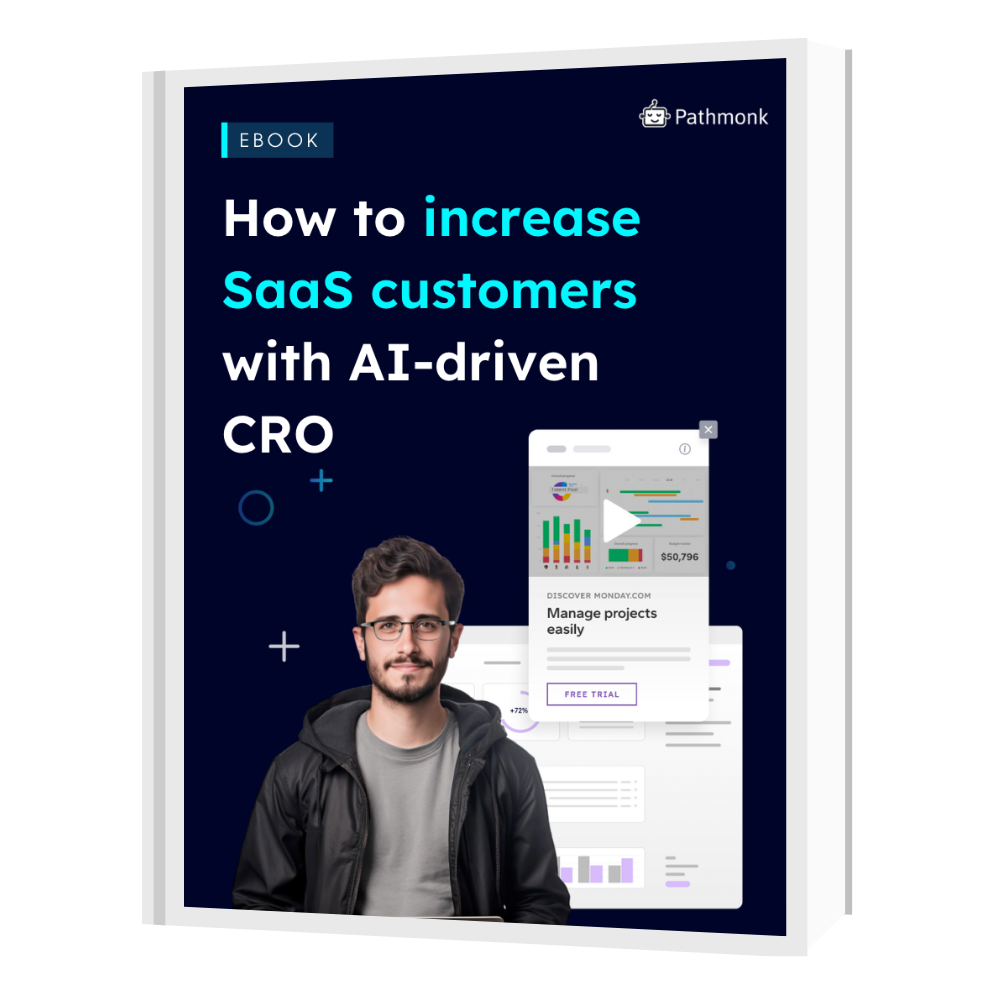
1. Automated A/B Testing
Automated A/B testing uses AI algorithms to continuously test different elements of a website or app, from button colors to page layouts. Unlike traditional A/B testing, which can be time-consuming and resource-intensive, Pathmonk Accelerate can analyze vast amounts of data quickly, identifying what works best for converting visitors into customers. This continuous optimization process ensures that SaaS platforms are always using the most effective design and content strategies.
2. Dynamic Pricing Optimization
By analyzing data on customer behavior, market demand, and competitor pricing, AI algorithms can adjust pricing in real time to match what users are willing to pay. This approach not only maximizes revenue but also ensures that prices remain competitive, attractive, and fair, boosting conversion rates.
3. Personalized Onboarding Experiences
Personalized onboarding experiences guided by AI can significantly enhance user engagement and conversion rates. AI can create customized onboarding flows based on the user’s behavior, needs, and preferences, making the process feel more relevant and less overwhelming. This tailored approach helps new users see the value of the SaaS product more quickly, encouraging them to commit to a subscription or purchase.
Retention and Upselling Strategies for SaaS Companies
In the competitive landscape of Software as a Service, retaining existing customers and maximizing their lifetime value is just as crucial as acquiring new ones. With the cost of acquiring a new customer significantly higher than retaining an existing one, SaaS companies are increasingly turning to sophisticated AI technologies to enhance their retention and upselling strategies. These strategies not only help in maintaining a stable customer base but also in identifying opportunities for additional revenue through upselling and cross-selling.
1. Churn Prediction: Proactive Customer Retention
One of the most impactful applications of AI in customer retention is churn prediction. By analyzing customer behavior, usage patterns, and other data points, AI algorithms can identify signs that a customer might be at risk of churning. This predictive capability allows companies to proactively address issues, whether they be related to customer satisfaction, product complexity, or unmet needs.
- Actionable Insights: Once at-risk customers are identified, targeted interventions can be deployed, such as personalized engagement campaigns, special offers, or direct outreach to address their specific concerns.
- Continuous Learning: As the AI model receives feedback from the interventions’ outcomes, it continually refines its predictions, making future efforts even more effective.
2. Recommendation Engines: Fueling Upselling and Cross-selling
AI-powered recommendation engines are transformative tools for identifying upselling and cross-selling opportunities within the existing customer base. By understanding individual customer needs, preferences, and usage patterns, these engines can suggest relevant additional services, features, or products, enhancing the customer experience and increasing revenue.
- Personalized Recommendations: Tailored suggestions that resonate with the customer’s specific context or use case significantly increase the likelihood of adoption.
- Timely Engagements: AI helps in determining the optimal time for making these suggestions, such as when a user has achieved a particular milestone with the current product offering.
3. Sentiment Analysis: Enhancing Customer Satisfaction
Sentiment analysis leverages AI to understand customer feelings and opinions from various data sources, such as support tickets, social media, and customer feedback. This analysis provides valuable insights into overall customer satisfaction and highlights areas needing improvement.
- Proactive Issue Resolution: By detecting negative sentiments early, companies can proactively address issues before they escalate into reasons for churn.
- Customer Engagement: Positive sentiments can be leveraged to engage customers further, such as by requesting reviews or testimonials, which in turn can aid in attracting new customers.
SaaS Marketing Case Studies: Success with Pathmonk Accelerate
Case Study: How Obzervr Boosted Conversions by 280% with Pathmonk
- Background: Obzervr is at the forefront of providing innovative digital solutions for personal assistant services and mining asset management. Their platform revolutionizes fieldwork processes by enhancing productivity, improving safety, and eliminating paper-based inefficiencies.
- Challenge: Despite their cutting-edge platform, Obzervr faced hurdles in increasing conversion rates, especially among enterprise buyers. The complex and lengthy buying journey, involving numerous decision-makers and detailed research, made it difficult to achieve their conversion goals.
- Solution: CEO Tania Walter sought to optimize the buying journey without overhauling the website. Turning to Pathmonk, Obzervr was able to tailor website interactions to user needs, enhancing the buying experience and guiding prospects through the decision-making process. Pathmonk’s integration facilitated targeted content delivery at various journey stages and enabled personalized experiences, driving user engagement and conversions without necessitating website changes.
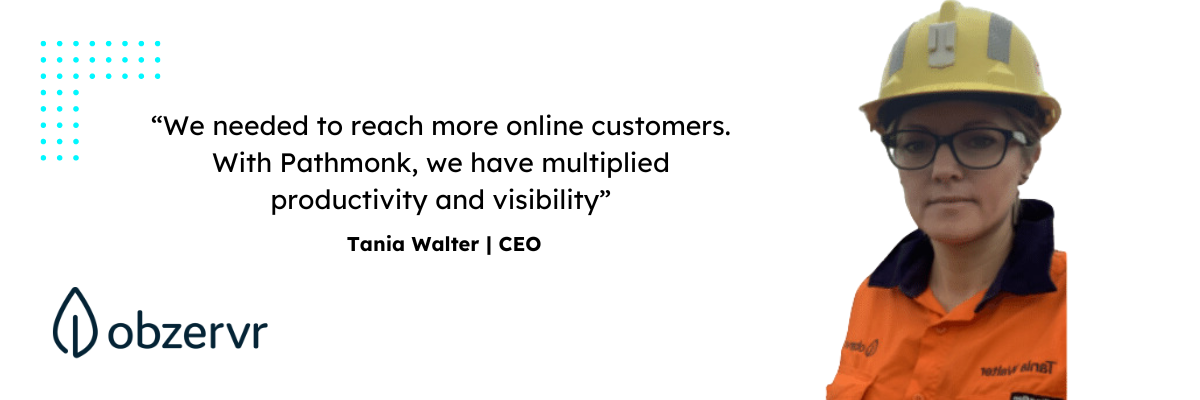
Results
280% Increase in Conversions: Following Pathmonk’s integration, Obzervr saw a dramatic uplift in lead generation and conversions.
Enhanced User Engagement: The tailored experiences led to a surge in user engagement, addressing inquiries at crucial buying stages.
Higher Quality Prospects: There was a noticeable rise in highly qualified leads, indicating the success of Pathmonk in navigating users through their decision-making.
Case Study: Remo’s Path to $30k Revenue Increase with Pathmonk
- Background: Remo is an innovative platform designed to transform virtual communications by facilitating authentic connections worldwide. As the demand for virtual event solutions surged, Remo faced the challenge of guiding users through a complex digital buying journey while maintaining the personal touch of face-to-face interactions.
- Challenge: The digital landscape for virtual event platforms is intricate, requiring a nuanced approach to support users effectively. Remo aimed to replicate the support and guidance of in-person interactions in the online environment, a task made more challenging by the rapidly evolving market needs due to the pandemic. Aaron Mohammed, Remo’s Product & Growth Manager, recognized the need for a strategy that enhanced the online experience to drive conversions and revenue growth.
- Solution: Remo’s approach centered on refining their conversion strategy to focus on demo requests, identifying this as a critical pathway to support user decisions. By integrating Pathmonk’s personalized interactions, Remo offered micro-experiences that provided users with tailored guidance at key decision-making moments. This focus on demo-request conversions aimed to equip users with the necessary information and assistance, supported by Pathmonk’s intelligent technology and its seamless integration with Remo’s HubSpot ecosystem.
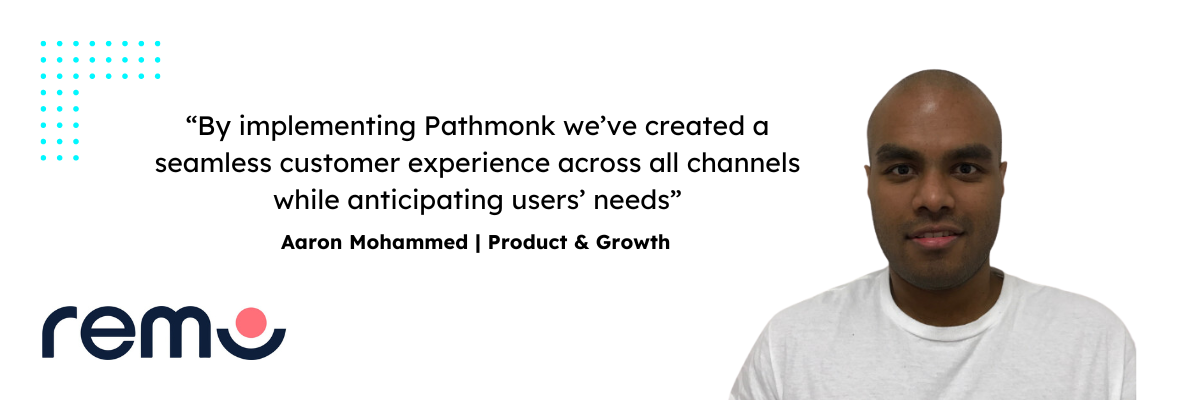
Results
Revenue Boost: A remarkable $30,000 revenue increase within just four weeks.
Enhanced Engagement: A significant uptick in sales calls and website conversations, indicating higher user engagement and interest.
Informed Decisions: Users were more inclined to book demos, feeling better supported throughout the buying journey.
Effective Strategy: The shift towards demo-request micro-experiences proved more effective than offering free trials.
Pathmonk Accelerate: Best AI-Powered SaaS Marketing Software
Pathmonk Accelerate stands out as a leading AI-powered marketing software that uses AI to help SaaS businesses grow faster and more efficiently. increasing sales from their website by turning visitors into customers. Its key features include:
- Reduced Customer Acquisition Costs: By increasing the efficiency of your website’s conversion funnel, Pathmonk Accelerate helps lower the overall cost of acquiring new customers. More effective conversions mean that every marketing dollar spent yields a higher return, optimizing your marketing budget.
- Personalized Marketing at Scale: Pathmonk’s AI-driven approach enables personalized engagement with hundreds or thousands of website visitors simultaneously. This level of personalization, which would be impossible to achieve manually, ensures that each visitor’s experience is optimized for their needs and preferences, significantly enhancing the likelihood of conversion.
- Faster Iteration and Optimization Cycles: The AI and machine learning algorithms behind Pathmonk Accelerate allow for rapid testing and iteration of different website elements. This means you can quickly identify what works best for your audience and adjust your strategy accordingly, staying agile in a competitive market.
- Seamless Integration with Existing Tools: Pathmonk Accelerate is designed to work harmoniously with your existing marketing and analytics tools, ensuring a smooth implementation into your current ecosystem without the need for extensive changes or overhauls.
- Boosted Retention Rates: By improving the initial user experience and ensuring that users find value quickly, Pathmonk Accelerate can also contribute to higher customer retention rates. Satisfied users from the outset are more likely to remain engaged and less likely to churn.
Ultimately, Pathmonk Accelerate empowers your SaaS company to not only attract and convert leads more effectively but also to understand and engage your audience in a way that fosters long-term loyalty and growth. By leveraging this AI-driven tool, you position your business to meet and exceed the evolving expectations of your customers, driving sustainable success.
Conclusions
In conclusion, AI is not just an optional tool for SaaS companies—it is becoming a critical component of successful marketing strategies. Its ability to analyze vast amounts of data, predict customer behavior, and automate personalized engagements is revolutionizing the SaaS marketing funnel.
Furthermore, the use of AI in identifying upselling and cross-selling opportunities presents a lucrative avenue for increasing revenue without the significant costs associated with acquiring new customers. By predicting churn, SaaS companies can proactively engage at-risk customers, addressing their concerns and improving overall satisfaction, thereby reducing turnover and enhancing the customer base’s stability.
As AI technology continues to advance, its role in driving efficiency, growth, and customer satisfaction in the SaaS industry will only become more significant. SaaS companies that embrace and effectively implement AI into their marketing strategies are poised to lead the market, achieving sustainable growth and building enduring relationships with their customers.





